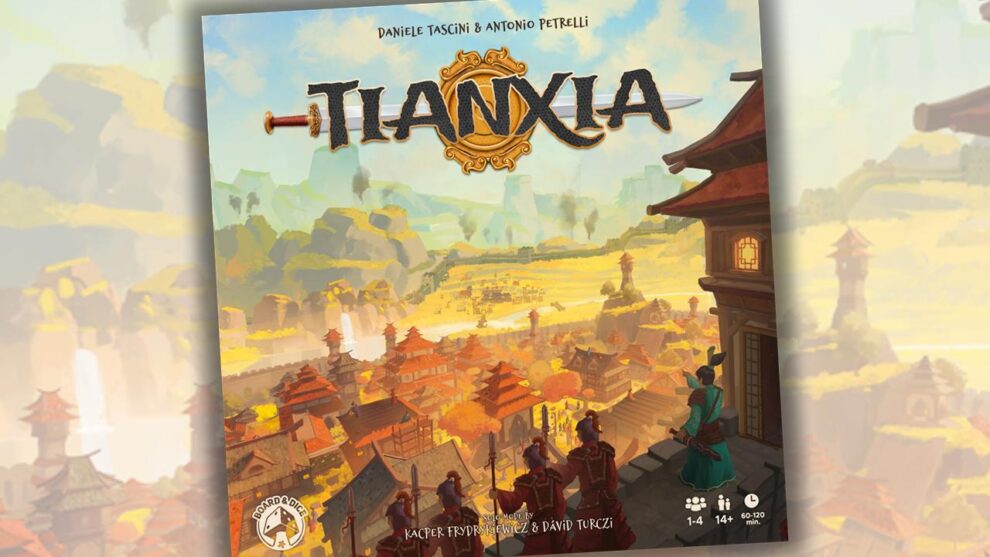Disclosure: Meeple Mountain received a free copy of this product in exchange for an honest, unbiased review. This review is not intended to be an endorsement.
Games designed by the Italian strategy game designer Daniele Tascini are very popular in my circles. I think Tiletum is his best work—a co-design with Simone Luciani, the man who has given us more classics than I can count—but Tascini has made so many great games that the players in my strategy game networks are always willing to join me for fresh plays.
Tascini, along with fellow Italian Antonio Petrelli, is the co-designer of Board&Dice’s latest Eurogame creation, Tianxia. The game checks almost every modern Eurogame design box. There are tracks, obviously, as well as one-time bonus actions and end-of-track bonuses available to each player. Asymmetric player bonuses are also available, in the form of a kicked-out action mechanic similar to recent designs like Galactic Cruise or a couple of Vital Lacerda’s legacy hits. Tianxia’s variable setup leads to a wide range of ways to attack each game’s puzzle, and the list of free actions exceeds the number of main actions available.
Various board elements, here in the form of 12 different income and/or passive ability buildings, take the place of technologies used in other similar games, with space for a limited number of players to access each tech. There are private milestone cards that are multi-use, there is a solo mode co-designed by David Turczi, and there are scores that will consistently reach triple digits.
“How is this Euro different from every other Euro released in the last few years?” is the question I get when I get games like Tianxia to the table. That’s fair, because there really are hundreds of similar games out there.
For Tianxia, the answer is the “Attack” phase…because I haven’t told you that marauders are about to cross the Great Wall of China to take out the community unless players work together to stop the attacks! That turns Tianxia into a game with area control scoring elements…and that was a break point for our overall opinion of how the game plays.
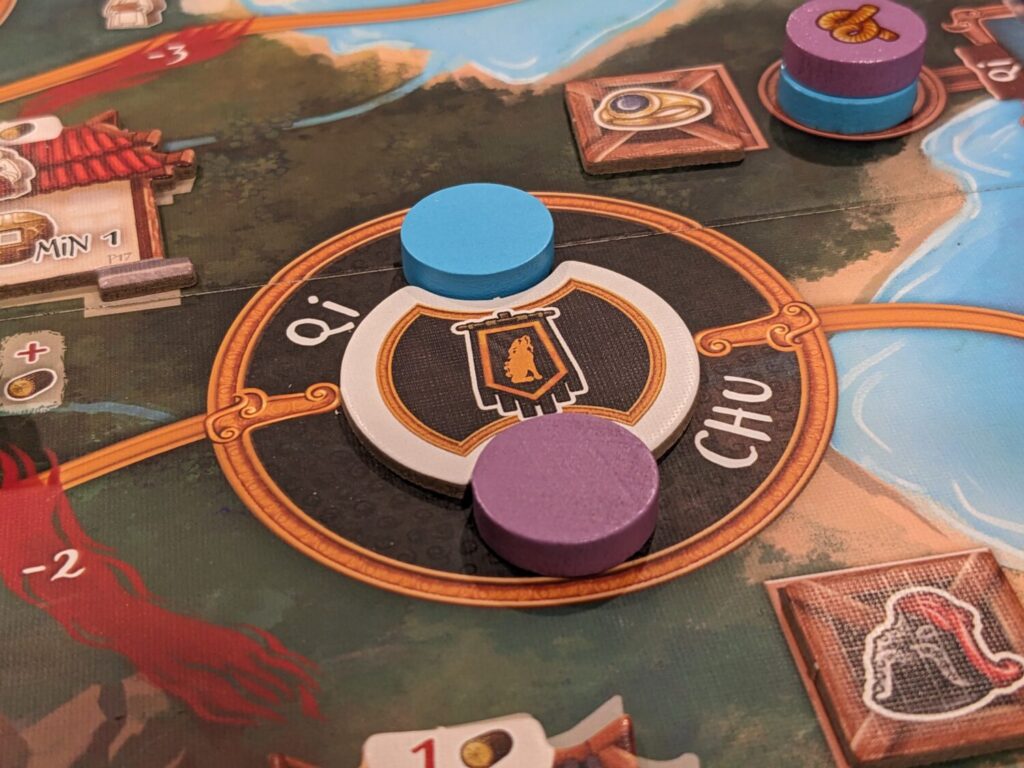
Variable Board Setup is Where It’s At
Tianxia is an action selection game for 1-4 players. Really, the game is always at least a three-player game, because a bot holds the fourth position on each of the game’s four tracks in games with less than four players, affecting end-game scores. In two-player games, a bot deck is used to block action spaces, simulating a three-player game. (Solo play is surprisingly easy to administer, with a solo mode co-designed by Turczi and Kacper Frydrykiewicz. I am the first to admit that I am often frightened to open a Turczi solo rulebook, because there are often so many new rules for solo that I don’t want to learn another set of already complex instructions. Not the case with Tianxia.)
The game is set in the “Warring States” period, roughly 300 BC. As leaders of noble families of the era, players are tasked with earning the most prestige (points) by selling goods to outbound shipping vessels, placing Governor tokens in some of the game’s locations, building walls and recruiting soldiers to defend the realm, and adding workers to local barges to produce resources.
Over the course of four rounds, games play out across five phases, three of which are basically administration. This includes setting up a Nomad attack token, representing outside marauders bent on attacking the Seven Kingdoms by reaching one of the four sections of the Great Wall. In each round, a random card draw determines how far each token advances towards the Wall, and with what strength (ranging from 4-14 points) the Nomads will have when they attack. The math is simple—the players have to collectively build enough defense to match the marauder strength, or bad things will happen when the attack occurs.
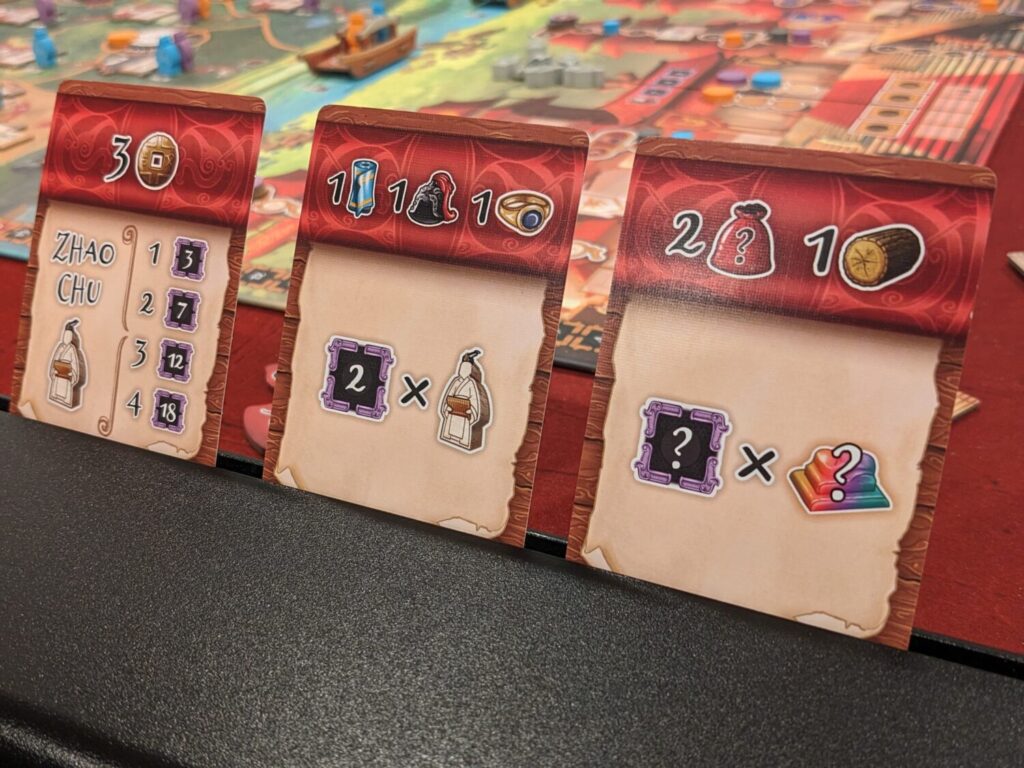
We’ll come back to the idea of “bad things”, though. The core of the game is the Action phase, when players do a mix of things to go up tracks, trade with the locals, and build up their engine to produce the resources needed to install Governors and defenses. After all players have passed, the Attack phase is resolved before a simple cleanup step wraps up each of the game’s four rounds.
For a game of this weight, Tianxia is extraordinarily easy to teach. The game’s core rules and main concepts take up just seven pages of the rulebook, and the game’s solo mode was a great teaching tool to help inform how the game plays. The production, typical of other experiences from Board&Dice, is excellent, from the player aids to the rulebook to the appendix that includes a full description of every icon in play. I loved the way the game used standard, but classier and screen-printed, meeples to play four different parts in each play—for example, if a meeple is standing on the cute little barge tokens, it’s a worker, with an icon that was usually clear from across the table. And if it’s a soldier, it’s got a different picture, and it is standing near the Wall sections.
As a Euro-style strategy game, Tianxia worked well also. Two of the guys in my strategy group joined me for my two multiplayer plays—my third play used the solo bot deck—and both people greatly enjoyed everything about our first play and most elements of our second play. The buildings in the main regions offer incredible strategic variety, in the portion of the board where players will place an action disc to install governors or engage with a shipping mechanic that allows for the trade of good tokens to get points, track bumps and other bonuses.
Nothing about these things feels particularly unique—particulary for anyone familiar with Tascini’s catalog—but the package comes together nicely, especially in the initial rounds as players race to install governors at the buildings that will inform a particular game’s strategy. Mixed with a draftable starting income building that is placed on each player’s board, the buildings are the main reason I could imagine keeping Tianxia in the collection. The special bonuses on each player’s personal board—triggered when workers are kicked off of barges, then becoming merchant meeples—are a mix of the mundane and the magical, with some powers being so juicy that I now see the reason why the player boards must be drafted before each game.
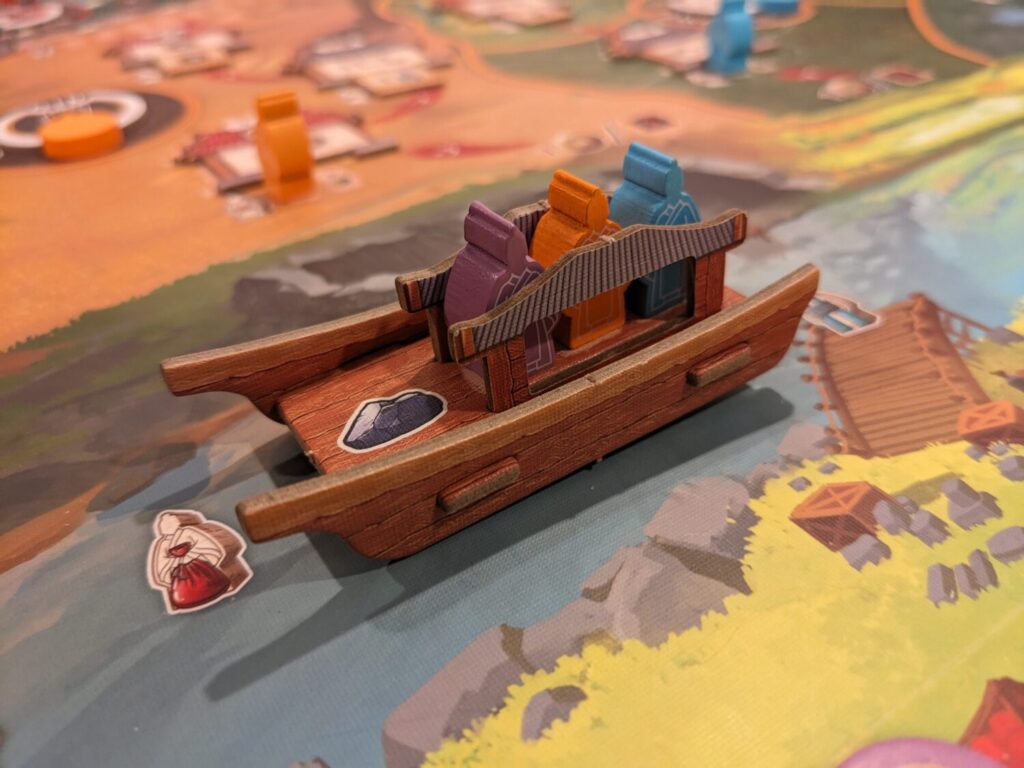
“I’ll Send a Guy”
My main issues with Tianxia are twofold.
The first is money. Simply put, money (here in the form of coins) is super, super tight in Tianxia. Coins are used for a variety of reasons, but the most important use is tied to action selection. If there is a disc in an action space that you want to use (including your own), you have to spend a coin for every other action marker at that location. You also have to spend at least one coin to place a worker on a barge, more if any of your own workers are already on the same barge. If you want to push up a track after passing in a round, that will cost you coins. If you want to trigger certain board actions, that will cost a coin, too.
Tianxia puts the screws to players regarding money almost immediately. Also, there is no automatic income in Tianxia, besides a player’s starting income building drafted during setup. Across my three plays, I began a new round with no coins in at least half of those rounds. The game has just nine action spaces. Going last in turn order can be disastrous in this game. In some ways, this is a positive—if turn order is supposed to be important, I want to see that surface in the design. That absolutely happens in Tianxia, and I can only imagine this being worse in a four-player game!
But that also means money is going to feel tight, maybe too tight for some players. I don’t think this is necessarily a flaw, but speaking of games like Galactic Cruise, where money is not tight and getting cash quickly is quite easy, some players will want more flexibility in their ability to take actions. Tianxia is a serious strategy game with a seriously tight economy.
The cash thing should be noted, but the reality is that it’s a minor issue in my mind. The real issue I have with Tianxia is the Attack phase scoring. That’s because it feels thematically off.
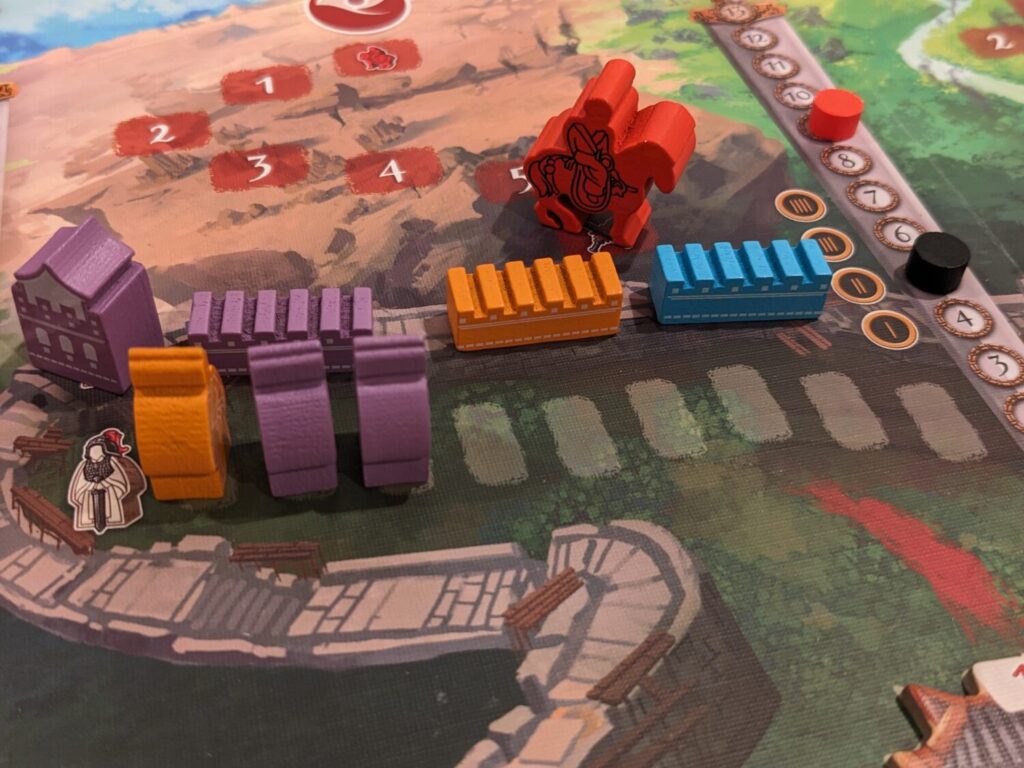
During the Attack phase, players first determine where there will be a fight in a given round. (The game offers two Nomad attack decks, one labeled “Easy” and one labeled “Normal.” There will definitely be less attacks with the Easy deck, so I’m leaning on that as the preferred route for future plays.) If the Nomad token has reached its final space, it will be sitting next to the Wall section of each column on the board, so it’s usually easy to tell if a fight is coming or not.
Then, players must check the Nomad’s current attack strength. This was built using the attack cards from the current and previous rounds, with a range of 4-14 strength points. That total is tracked using a red marker on a large sword icon next to each column. Again, easy-peasy.
Defense strength is then tallied, using a marker that can also be used to track the strength during the round. This total includes any tower or wall tokens built by the players in that section, as well as the total number of soldiers trained by players.
If the players provided as much or more defense than the Nomad strength count, the players “win.” By that, I mean that no other buildings in the column beneath that wall get destroyed by the Nomad token. (Yes, all of this felt a LOT like the similar mechanic in Mindclash’s tower defense Euro Perseverance: Castaway Chronicles—Episodes 1 & 2.) In Tianxia, the player that provided the most strength earns seven points, with other contributors earning less. All players score points for any soldiers killed off during the combat, and if any Governors survived the attack, the person who provided the most initial strength scores points for those meeples regardless of whose meeples they are.
But players can score points even if the result of the attack led to the Nomads destroying all the buildings in that section. In one extreme example, we had a game where the Nomad attack strength was maxed out at 14. The blue player sent one soldier near the end of the round. For their efforts, they scored seven points for providing the most strength, and one point for having their soldier get wiped off the map.
So, whether players successfully defend an attack or not, the area majority scoring still scores the same way. Thematically, this feels way off. One player loved this scoring element, as a way to ensure that a player who defends a section by themselves still gets paid (in points) for their efforts. To me, I would have enjoyed this scoring more if there were bigger consequences for players who simply skipped their part in helping to defend a portion of the board.
The rules are the rules, but as it relates to the Attack, I don’t love the parameters there.

There’s Something Here
For players who were disappointed with aspects of Tascini’s other big 2025 release, Transgalactica, I think you’ll find a more traditional interaction point with Tianxia’s design. This is a big ol’ Euro with all the fixins you’ll be accustomed to. All of Tianxia’s systems play well with each other, in a package that hits lots of heavy Euro notes and can be played in under two hours. The rules and rulebook editing by Tyler Brown are noteworthy; as a person that teaches a couple of games of this weight each month to new players, I am so happy with how this turned out as a production in terms of accessibility.
And, there’s beige and brown, like, everywhere. While the tracks come in different colors, most of the beige elements I want in my Euros are here. The bonus tiles? All beige. Shipping and demand tiles? Beige. One of the player colors is supposed to be orange, but one player did say that it leaned more beige-orange than orange, which I agree with. The goods tokens come in a brown hue that fits just right, and the milestone cards feature a backing that worked well also. As a fan of beige (I am in the minority, but I think the Tiletum board is beautiful), Tianxia does a great job of mixing the traditional look of a beige Euro with an updated color scheme that brings the game’s other elements out with a nice visual pop, particularly with the player boards.
I also think Tianxia’s main board is gorgeous and does a great job of hiding its tracks in attractive illustrations of temple-like buildings in the bottom third of the board.
Despite my issues with some game elements, Tianxia was mostly a winner. Will it stand out in a crowd, especially from a publisher known for producing so many great Euro-style games? Time will tell. Like other titles, Tianxia already has a little room for expansion content, be it new objective cards, additional player powers, and ways to change up its economy. For now, I like what I see!


